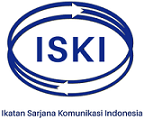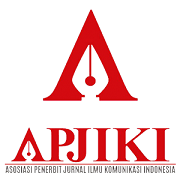MODEL HIERARKI KOMUNIKASI ORGANISASI BADAN RESERSE DAN KRIMINAL KEPOLISIAN REPUBLIK INDONESIA (BARESKRIM POLRI)
Abstract
Abstrak
Tugas pokok yang dijalankan oleh organisasi Polri dibentuk secara nasional dengan konsep organisasi berjenjang mulai dari tingkatan yang bersifat fungsional antara lain fungsi Intelijen, Reserse, Sabhara, Lalu Lintas dan Pembinaan Masyarakat. Namun dalam implementasinya hierarki komunikasi organisasi yang dikembangkan belum berjalan optimal. Tujuan penelitian ini adalah untuk mengkaji tentang model hierarki komunikasi organisasi Badan Reserse dan Kriminal Kepolisian Republik Indonesia (Bareskrim Polri). Penelitian ini menggunakan jenis penelitian kualitatif yaitu peneliti mengeksplorasi suatu entitas atau fenomena (kasus) dan aktivitas (program, kejadian, proses, institusi, atau kelompok) terkait pembelajaran di Bareskrim Polri. Pengumpulan data dilakukan dengan metode wawancara dengan informan kunci yaitu. Metode ini ditujukan untuk mendapatkan database informasi yang ada pada setiap informan yaituPimpinan Polri/Kabareskrim Polri atau wakabareskrim, Direktur/Wakil Direktur Bareskrim Polri, Karo Wasidik, Kasub Dit, Kanit, Penyidik. Tehnik analisis data dilakukan dengan membaca dan memahami berbagai materi emperik (emperical material) yang telah dikumpulkan tersebut kemudian mengkaitkannya dengan key themes pada penelitian ini. Hasil penelitian ini membuktikan bahwa model hierarki komunikasi mengarahkan kepada siapa anggota organisasi berinteraksi dan berkomunikasi sehingga tidak dianggap salah (secara etika dan displin) baik dalam bersikap dan berperilaku khususnya dalam hubungan person to person. Disisi lain, juga mempunyai hubungan dan saling terkait yaitu mempengaruhi pengelolaan organisasi yang muncul dalam bentuk keputusan, kebijakan dan arahan baik tertulis maupun lisan. Model hierarki komunikasi mendorong terjadinya manajemen pembelajaran yang tertib karena selain tetap membuka pola komunikasi dua arah, diskusi dan dialog serta di dalamnya ada kritik, masukan dan saran. Namun model komunikasi hierarki mensyaratkan komunikasi tersebut secara formal harus berpedoman pada etika, prosedur dan tata cara tertentu.
Abstract
The purpose of this study is to examine the hierarchical model of organizational communication for the Indonesian National Police (Bareskrim Polri). This research uses a qualitative research type, namely, researchers explore an entity or phenomenon (cases) and activities (programs, events, processes, institutions, or groups) related to learning at the Police Criminal Investigation Unit. Data collection was carried out by the interview method. This method is intended to obtain a database of information on each informant. The analysis technique is done by reading and understanding various empirical materials that have been collected and then linking them to the key themes in this study. The results of this study prove that the hierarchical communication model directs to whom the members of the organization interact and communicate so that they are not considered wrong (ethically and disciplinarily) both in attitude and behavior, especially in person to person relationships. On the other hand, it also has a relationship and is interrelated, namely influencing organizational management that appears in the form of decisions, policies, and directions both written and oral. The hierarchical communication model encourages orderly learning management because apart from keeping open two-way communication patterns, discussions, and dialogues, and includes criticism, input, and suggestions. However, the hierarchical communication model requires that communication be formally guided by certain ethics, procedures, and procedures.
Keywords
Full Text:
PDFReferences
Blazenaite, Aukse. 2011. Effective Organizational Communication: in Search of a System. Socialiniai Mokslai, Vol. 4 (74)
Brown, J. (1992). “Changing the Police Culture”, Journal Policing, Vol 8, No 4, Winter
Danendra, K.B.I. (2012). Kedudukan Dan Fungsi Kepolisian Dalam Struktur Organisasi Negara Republik Indonesia. Jurnal Lex Crimen Vol.I, No.4
Dewan, R., Seidmann, A., & Sundaresan, S. (1997). Communications in Hierarchical Organizations and Standards Policies for Information Technology. International Journal of Electronic Commerce, 1(3), 43-63. Retrieved December 12, 2020, from http://www.jstor.org/stable/27750819
Hanson, Krackhardt. Informal Network: The Company Behind the Chart, Harvard Business Review, pp.63,July/Agust,. 1993
Hinshaw, R.E. 1980. “Anthropology, Administration and Public Policy”, Annual Review of Anthropology, 9: 497-522.
Johnson-laird. (1983). Mental models, Library of Congress Catalog in Publicition Data, US of America.
Leonard L. Sayles dan George Strauss. (1996). Human Behavior in Organizations. Englewood Cliffs, NJ, Prentice Hall.
Nanus, Burt and Stephen M. Dobbs .(1999). Leaders Who Make a Difference, Joosey-Boss Publisher.
Peraturan Kapolri nomor 16 tahun 2012 tentang mutasi personel Polri, dalam pasal 4 angka 2 huruf e.
Roy R. Roberg dan Jack Kuykendall dalam Police and Society. (1993). Wadsworth Publishing Company, Belmont, California A Division of Wadsworth, Inc.
Shanahan, P. (2000). “Police Culture and the Learning Organisation: A Relationship?”, AVETRA Conference Papers.
Widhiastuti, H. (2012). The Effectiveness of Communications in Hierarchical Organizational Structure. International Journal of Social Science and Humanity. Vol. 2, No. 3
Yahaya, Muhammad, et. al. 2018. Organizational Structure And An Effective Communication: The Moderating Effect Of Transformational Leadership. International Journal Of Scientific & Technology Research Volume 7, Issue 11, November 2018
DOI: http://dx.doi.org/10.30829/komunikologi.v4i2.8480
Refbacks
- There are currently no refbacks.
Copyright (c) 2020 Dadang Hartanto

This work is licensed under a Creative Commons Attribution-ShareAlike 4.0 International License.
INDEXING BY :
======================================
Published by :
Fakultas Ilmu Sosial UIN Sumatera Utara
Medan, Indonesia
Editorial Office :
Jl. Williem Iskandar Psr.V Medan Estate 20371

Komunikologi: Jurnal Pengembangan Ilmu Komunikasi dan Sosial by Program Studi Ilmu Komunikasi UIN Sumatera Utara Medan is licensed under a Creative Commons Attribution-ShareAlike 4.0 International License
Based on a work at http://jurnal.uinsu.ac.id/index.php/KOMUNIKOLOGI/index





























